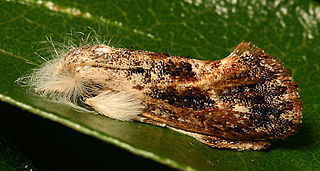
Acrolophus is a genus of moths in the family Acrolophidae, with, typically, great individual variation within species in color pattern, making field identification of many individuals difficult or impossible. It was described by Felipe Poey in 1832.

Catocala lineella, the lineella underwing, little lined underwing or steely underwing, is a moth of the family Erebidae. The species was first described by Augustus Radcliffe Grote in 1872. It is found in North America from Ontario and Quebec south to Florida west to Texas and north to Ohio.

Zanclognatha laevigata, the variable zanclognatha, is a litter moth of the family Erebidae. It was described by Augustus Radcliffe Grote in 1872. It is found in North America from Manitoba to Nova Scotia, south to Florida and Missouri.

Zanclognatha obscuripennis, the dark zanclognatha, is a litter moth of the family Erebidae. It was described by Augustus Radcliffe Grote in 1872. It is found in North America from Missouri to Quebec, south to Florida and Texas.

Isogona tenuis, the thin-lined owlet, is a moth of the family Erebidae. The species was first described by Augustus Radcliffe Grote in 1872. It is found from Ontario, Wisconsin, Ohio and New Jersey, south to Florida and Texas.

Hypena sordidula, the sordid hypena or sordid bomolocha moth, is a moth of the family Erebidae. The species was first described by Augustus Radcliffe Grote in 1872. It is found in North America from Quebec and Maine south to northern Florida and Texas, west to Louisiana and Kansas, north to Manitoba.

Colobochyla interpuncta, the swamp belle or yellow-lined owlet, is a moth of the family Erebidae. The species was first described by Augustus Radcliffe Grote in 1872. It is found in North American wetlands from Wisconsin to Nova Scotia south to Florida and Texas.

Phyprosopus callitrichoides, the curve-lined owlet, is a moth of the family Erebidae. The species was first described by Augustus Radcliffe Grote in 1872. It is found in the US from New Hampshire to Florida, west to Montana and Texas.

Cirrhophanus triangulifer, the goldenrod stowaway or tickseed moth, is a moth of the family Noctuidae. The species was first described by Augustus Radcliffe Grote in 1872. It is found in the US from New York to Florida, west to Texas and Oklahoma, north to Wisconsin. In Canada, it has only been recorded from Ontario.

Arta statalis, the posturing arta moth, is a species of snout moth in the genus Arta. It was described by Augustus Radcliffe Grote in 1875 and is the type species of its genus. It is found in North America including Delaware, Florida, Georgia, Illinois, Iowa, Massachusetts, New Jersey, New York, North Carolina, Oklahoma, Pennsylvania, South Carolina, Tennessee and Virginia.

Acrolophus morus, the dark acrolophus, is a moth of the family Acrolophidae. It was described by Augustus Radcliffe Grote in 1881. It is found in North America, including Florida, Georgia, Illinois, Kentucky, Maryland, Massachusetts, Mississippi, New Hampshire, New York, North Carolina, Ohio, Quebec, South Carolina, Tennessee, Virginia and West Virginia.
Cisseps packardii is a moth of the subfamily Arctiinae. It was described by Augustus Radcliffe Grote in 1865. It is found in North America from California to Manitoba.

Grammia anna, the Anna tiger moth, is a moth of the family Erebidae. It was described by Augustus Radcliffe Grote in 1863. It is found from Maine to the mountains of North Carolina, west to Nebraska and Arkansas.
Halysidota cinctipes, the gartered halysidota or Florida tussock moth, is a species of moth in the family Erebidae. It was described by Augustus Radcliffe Grote in 1865. It is found on Cuba, Haiti, the Bahamas and in the US states of Florida, Texas, Arizona and California. The range possibly extends through Mexico, Guatemala, Costa Rica and Panama to Venezuela, Brazil and Peru.
Inopsis funerea is a moth of the family Erebidae. It was described by Augustus Radcliffe Grote in 1883. It is found in North America, where it has been recorded from Arizona and South Carolina.

Leucanopsis longa, the long-streaked tussock moth or long-streaked halisidota, is a moth of the family Erebidae. It was described by Augustus Radcliffe Grote in 1880. It is found from North Carolina to Florida and west along the coast to eastern Texas. The habitat consists of marshes and wet sedge meadows.

Cisthene packardii, or Packard's lichen moth, is a moth of the family Erebidae. It was described by Augustus Radcliffe Grote in 1863. It is found in the US from the states of New York to Florida and from Missouri to Texas. The habitat consists of barrens and dry oak woodlands in the northern part of the range and a variety of woodlands and scrubs in the south.

Chrysendeton medicinalis, the bold medicine moth, is a moth in the family Crambidae. It was described by Augustus Radcliffe Grote in 1881. It is found on North America, where it has been recorded from Alabama, Florida, Georgia, Illinois, Indiana, Kentucky, Maryland, Mississippi, North Carolina, Ohio, Pennsylvania, South Carolina, Tennessee, Texas and West Virginia.
Eulepte anticostalis is a moth in the family Crambidae. It was described by Augustus Radcliffe Grote in 1871. It is found in North America, where it has been recorded from Florida to North Carolina and west to Texas. It is also found on Puerto Rico.
Stiriina is a subtribe of owlet moths in the family Noctuidae. There are at least 50 described species in Stiriina.















